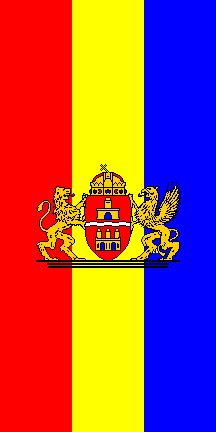
1:2 variant
image by István Molnár, 9 April 2001

Last modified: 2005-10-15 by dov gutterman
Keywords: hungary | budapest | buda | pest | lion | castle | danube |
Links: FOTW homepage |
search |
disclaimer and copyright |
write us |
mirrors

1:2 variant
image by István Molnár, 9 April 2001

2:3 variant
image by Antonio Martins, 25 October 2000
See also:
Other Sites:
Horizontally divided red-yellow-blue with the city's coat of
arms in the center. The blue shade is very bright and strong
(like Sweden's) and the flag appears to be 3:2. The coat of arms
has the same crest as on the national and the shield is red, a
wave silver horizontally dividing two castles, representing Buda
and Pest -- the castles are not regular heraldic ones, but a
(styled) representation of actual monuments. Two golden lions
rampant support the shield. Budapest is combined from two major
parts: Buda - on the western bank of the Danube, and Pest - on
the eastern bank of the Danube. Both parts were united in 1872 to
one city.
Antonio Martins , 9 May 1997
There were several reports that the blue stipe was replaced by
green one. It seems that this is not so.
Željko Heimer , 10 May 1997
The flag of the city of Budapest, Hungary, is shown here as
being a horizontal tricolor of red-yellow-blue. However, in the
Crampton book "The Complete Guide to Flags," the flag
of Budapest is described as "3 horizontal stripes of red,
yellow, and green with the city arms in the center" on page
64. Did the flag design change between the book's printing (1989)
and the observations (1997)?
Randy Young, 29 January 1999
IIRC, some groups (if they were organized groups at all?)
wnated Budapest flag to change from blue to green, due to the
similarity, as they put it, with the flag of Romania and
possibility of misinterpretation due to that. To my understanding
the issue was rather irrational and nationalisticly coloured, and
I guess that the officials did not take it seriously. In any
case, flags with blue are still used, as I can testify, as well
as some others that visited Budapest recently. As far as I know
green version was never used. The issue was raised in early 90's.
Red yellow and blue are colours taken from the Budapest CoA,
which is red with blue wavy bar and two castles one on each side
(a bit different, one to represent Buda and other Pest, the two
cities that Budapest is formed of, with Danube in the middle).
Since blue wavy line represent river Danube, it is hard to
interpret it as green.
However, I would not claim that "before my time" there
was not a different flag for Budapest, as I lack full
information.
Željko Heimer, 31 January 1999
Budapest came into existence in Fall 1873 out of three former
cities: ?buda (lit. "Old Buda"), Buda, and Pest. The
new flag for the new capital was designed based on the Hungarian
red-white-green tricolor: white became yellow and green became
blue. The red-yellow-blue tricolor with the city CoA remained the
flag of Budapest until the end of WW I (probably until 1920),
when it was officially changed to red-yellow-green with CoA.
Namely, in Fall/Winter 1919, after the collapse of the Soviet
Republic, along with the annexion of Transsylvania, the Partium,
the Banat, and Eastern Hungary, Romanian troops occupied
Budapest. Their blue-yellow-red tricolor became extremely
unwelcome in the capital. For this reason, Governor Horthy
(actually, he was elected in March 1920) ordered the above
mentioned change of the blue color. After WW II, almost all
county and city flags were abolished (an exception is Szeged,
which used its city flag--Communist version--in the 1980s). After
liberation, in or around 1990, the new city council decided to
re-establish the original, 1873 flag. From that time on, the
state flag or the national flag is (almost) always hoisted along
with the Budapest flag.
David N. Biacsi, 4 Febuary 1999
The flag was adopted in 30th September 1990 by the Soviet of
the Capital (before the elections of the councils).The correct
flag (that I know) is the 1:2 version.
István Molnár, 12 October 2000 and 9 April 2001
The change of the colours (blue/green) was in 1930! The
red-yellow-blue flag was used 1873-1930.
The red-yellow-green flag was used 1930-1946/1950. The present
flag is the red-yellow-blue from 1989.
István Molnár, 19 October 2000
![[Budapest flag]](../images/h/hu-budap.gif)
image by Antonio Martins, 28 Febuary 2001
The flag without the arms is also in use.
Željko Heimer , 10 May 1997
The official version is the 2:3
István Molnár, 27 May 2001

image by István Molnár, 9 April 2001

image by István Molnár, 27 August 2001
Flying flag at the Conquest Statue, Opusztaszer NHP. Ratio:
3:1. The width of the CoA is the 1/3 of the width of the flag.
The CoAs is on the 1/3 of the flag's height.
István Molnár, 27 August 2001
bp.jpg)
image from <www.budapest.hu>,
located by István Molnár, 12 October 2000
The CoA and the flag were adopted in 30th September 1990 by
the Soviet of the Capital (before the elections of the councils).
István Molnár, 12 October 2000
The St. Stephen (Szent Istvan) basilica construction started
in 1848, stopped immediatly, was resumed in 1851 after the War of
Independence, followed by the immediate death of the two
architects, and even the dome collapsed during the works. The
church was finally consecrated in 1905, and in 1931 it was
awarded the title 'basilica minor' by the Holy See. The right
hand of Stephen I, the first Hungarian king, the 'Holy Right', is
preserved here in a shrine exposed in a side chapel close to the
church entrance.
Three flags are displayed in the chapel:
- the Hungarian national flag with coat of arms and golden fringe, inproportion 1:2
- a vertical banner of proportion 2:1, vertically divided red and green, with a white Hungarian cross with curved edges. Flag has a golden fringe on the lower edge. Looks like a typical procession banner.
- a rectangular banner of proportion 1:2, horizontally divided yellow and blue, charged in the middle with Coat of Arms. I am not so sure of the charge, since it was rather dark.
The Holy Right is paraded by the faithful each 20st August,
and I guess the three flags are involved in the ceremony.
Historical informations are from the Budapest guide, released by
the Tourism Office of Budapest.
Ivan Sache, 14 October 2000
The "Hungarian cross flag" is the flag of the Saint Stephen Order of Knighthood (in
Hungarian: Szent István Lovagrend). The yellow-blue flag is the
flag of Budapest V. district -
Belváros-Lipótváros.
István Molnár, 16 October 2000
Flags of Budapest
Szabadkiköto - Budapest Free Port at <www.mahart.hu>.
István Molnár, 6 September 2005